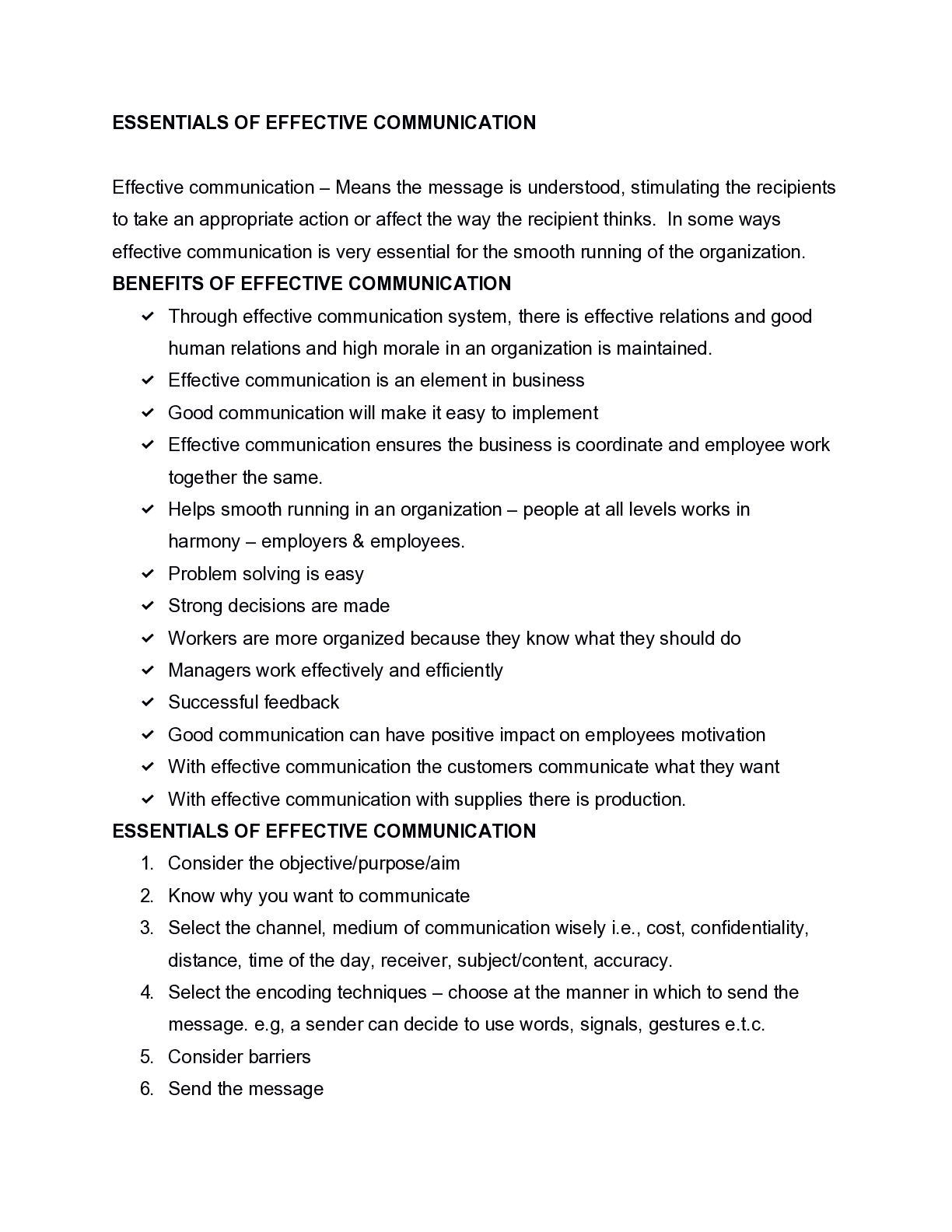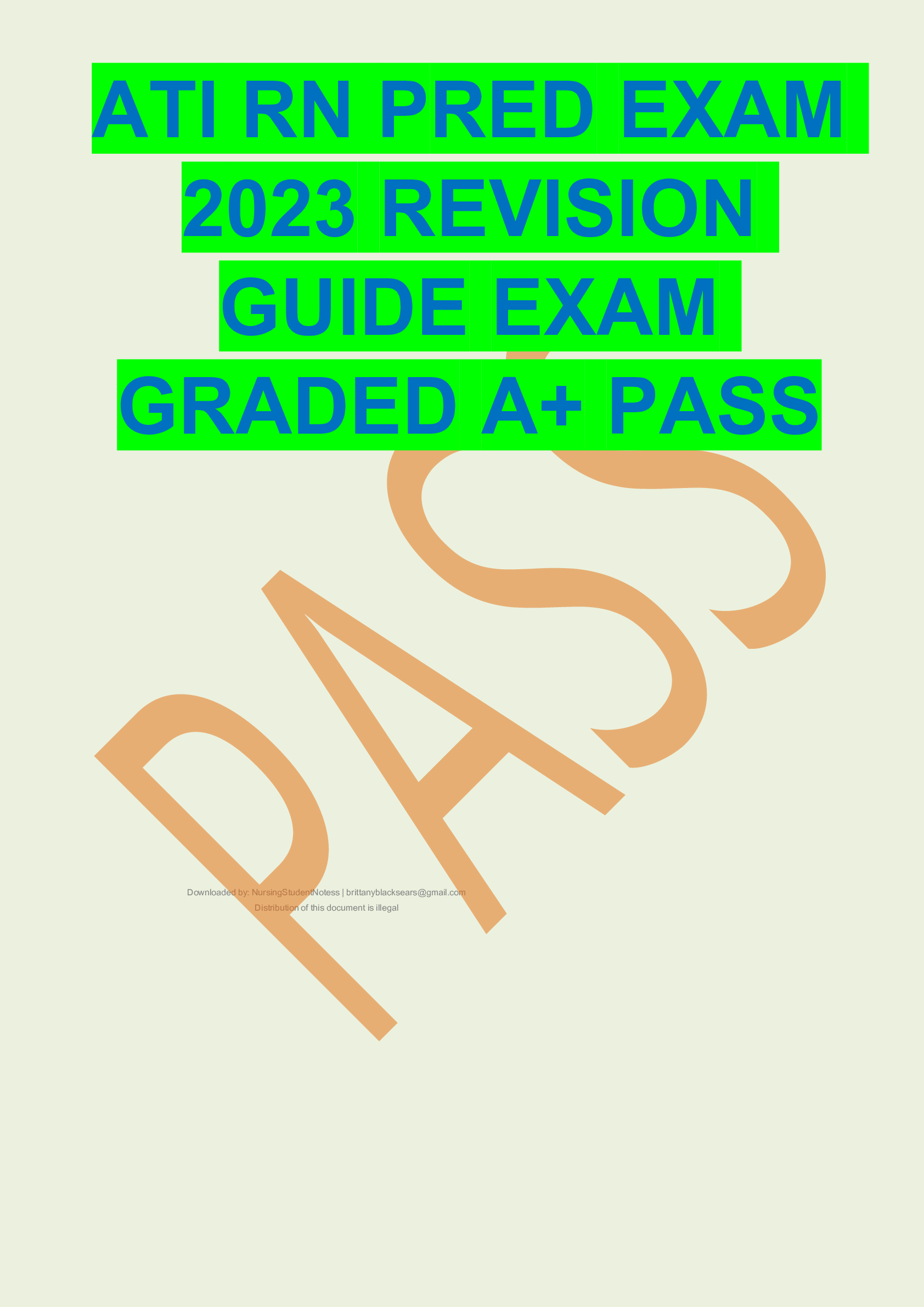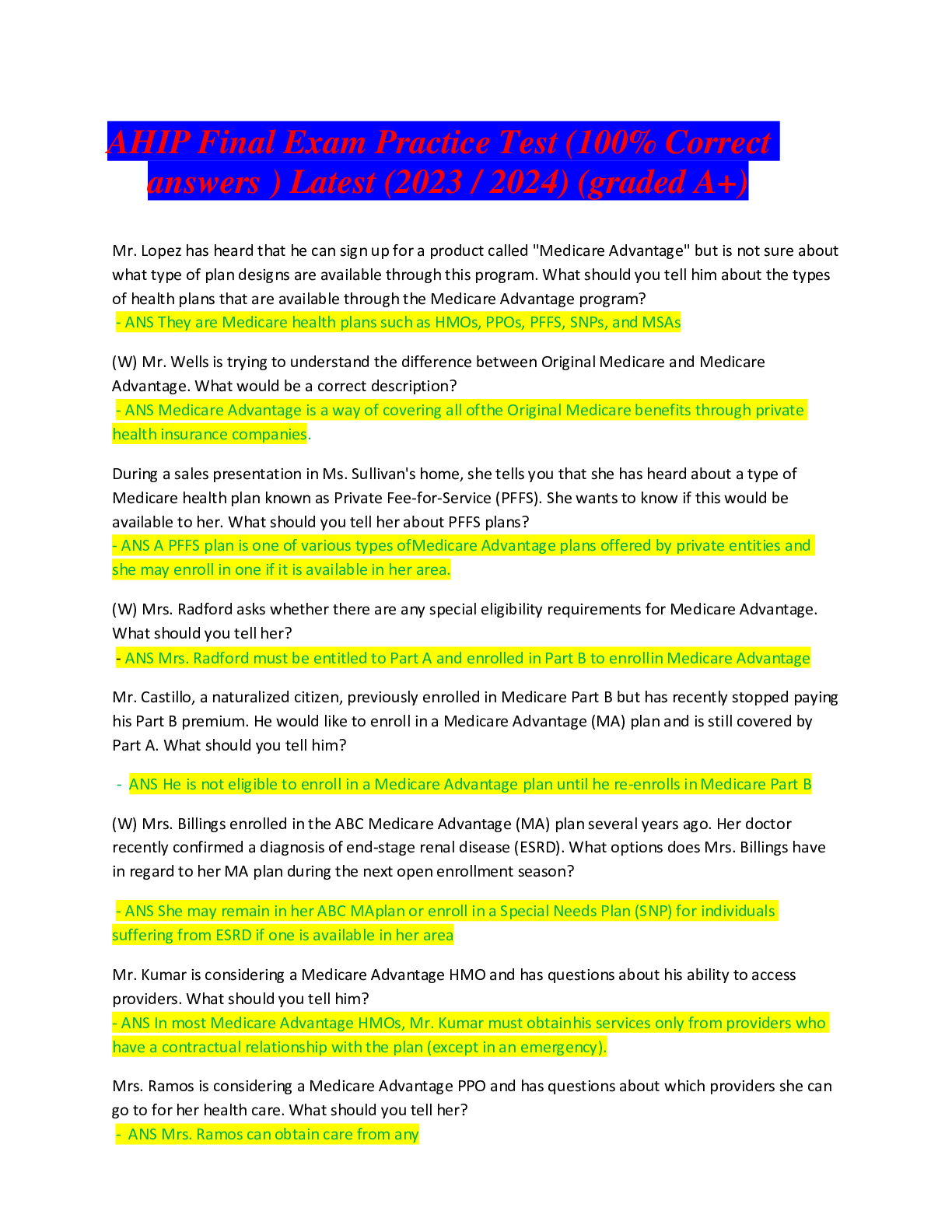Professional Teaching Knowledge > Annotated Bibliography > ESSENTIALS OF EFFECTIVE COMMUNICATION (All)
ESSENTIALS OF EFFECTIVE COMMUNICATION
Document Content and Description Below
ESSENTIALS OF EFFECTIVE COMMUNICATION Effective communication – Means the message is understood, stimulating the recipients to take an appropriate action or affect the way the recipient thinks. In... some ways effective communication is very essential for the smooth running of the organization. BENEFITS OF EFFECTIVE COMMUNICATION Through effective communication system, there is effective relations and good human relations and high morale in an organization is maintained. Effective communication is an element in business Good communication will make it easy to implement Effective communication ensures the business is coordinate and employee work together the same. Helps smooth running in an organization – people at all levels works in harmony – employers & employees. Problem solving is easy Strong decisions are made Workers are more organized because they know what they should do Managers work effectively and efficiently Successful feedback Good communication can have positive impact on employees motivation With effective communication the customers communicate what they want With effective communication with supplies there is production. ESSENTIALS OF EFFECTIVE COMMUNICATION 1. Consider the objective/purpose/aim 2. Know why you want to communicate 3. Select the channel, medium of communication wisely i.e., cost, confidentiality, distance, time of the day, receiver, subject/content, accuracy. 4. Select the encoding techniques – choose at the manner in which to send the message. e.g, a sender can decide to use words, signals, gestures e.t.c. 5. Consider barriers 6. Send the message 7. Check for understanding 8. Obtain feedback – information sender gets from receiver 9. Consider language- use the language the sender can understand 10. Message should be brief- long messages bore people 11. Use correct tone 12. Time your communication 13. Be polite 14. Use appropriate mannerism 15. Use logic communication – making some sense. PURPOSE OF COMMUNICATION 1. One is able to exchange views/ideas with other people 2. For better understanding between two parties or more 3. For greater efficiency – communication systems enable the management to instruct supervisors and subordinates staff. 4. Effective co-ordination – The employers will co-ordinate each other for the purpose of running of the organization. 5. Avoid Losses – If the employers and employees are in good terms, the employees can report any breakdowns. 6. The organization can inform customers the goods and services they have. ENCODING - The sender expresses his ideas into words symbols, signs or gestures to convey the message. - He decides what outcomes he wants from the communication and this will help him whether he will use gestures, signals, visual or words. MESSAGE - The encoded information is known as the message. It’s the subject matter. It contains words, symbols, signs, pictures, gestures or some other form which will make the receiver understand the message. - The message can take a form of a letter, a smile, a memo, a telephone call shrug of the shoulder e.t.c. MEDIUM A larger group of ways of communicating within which a particular communication can be classed. The following are media of communication. - Oral communication - Written communication - Non-verbal communication - Electronic communication - Visual communication CHANNEL The media through which the message passes from sender to the receiver. It may be formal, (Procedure), or Informal (grapevine) Oral – (meetings, interviews), written (letters, Memos,, Notices). RECEIVER The persons who receives the message. The message is directed to receiver, and the process cannot be complete without the receiver. He is the one responsible for decoding process. DECODING - Interpreting the meaning of the message. i.e. he/she interprets meaning of the smile, reads the letter and interprets the message encodes. - If the message is not carefully encoded by the sender may be mis-interpreted by its receiver. FEEDBACK The name given to the information which the sender receives from the receiver. It refers to the receivers immediate reaction to the message it can be a smile, a node, flown, shrug e.g. In a meeting the audience may smile or node to understanding or response. STEPS/STAGES OF COMMUNICATION PROCESS Sender (Idea) Message Encoded Information Encoding Information Receiver, Receives message Medium Channel Transmitted Receiver sends for the sender Complete Cycle of Communication Process. FUNCTIONS OF THE FEEDBACK 1. Helps the sender to know the receiver, has received its message 2. Helps communication to continue 3. Completes communication process It shows how the message was understood 4. Indicates communication barriers 5. Shows the effectiveness of the medium (Channel used). BARRIERS TO EFFECTIVE COMMUNICATION Barrier – Anything causing communication to be ineffective - Barrier changes the message - Barriers are going to interfere the process of sending and receiving of a message. The following are barriers to effective communication and their solution 1. Age Difference – Age gap between the sender and the receiver should be considered. If the sender does not consider the age of his audience he may create a barrier he may. He may create a barrier; he may give content beyond understanding. If the sender mixes the young people and the other people, he may not be comfortable to listen to the same content. The young people may not be put together for communication with small children because children can be a nuisance. SOLUTIONS - For effective communication people should be grouped according to their age. - You should not mix the audience and give contend suitable for the ages. 2. Social Economic Factors. May create a barrier during communication, high class people may look down, the low call people. For this reason there may be a barrier if one group communicates with the other. The high class may feel low class have nothing to offer. The low class may feel the high class people are too proud and hence not ready to listen to them. SOLUTION - The rich should treat the poor kindly and take them as people - The rich should create a friendly atmosphere - The poor should appreciate their status and should not undermine themselves - There must be mutual understanding between the poor and the rich. 3. Language Barrier If the sender uses a language that the receiver cannot understand he/she creates a language barrier e.g. kimeru vs. Kimasai If the sender uses language full of technical jargon – A language that cannot be understood within a given context. Where language is beyond recipients understanding (complicated). SOLUTION - Use common language for effective communication - Consider education level of the recipients - Simplify the vocabularies for your audience – use simpler language for easy understanding. 4. Competition for Attention If there are some factors acting against receivers’ attention, the receiver cannot really concentrate on the communication. They Include:- Distractors, Receivers, health, fatigue, having some other his in mind, difficult information, very deep information, receiving information from different sources. SOLUTION - Getting information from one source - Do not give information when one is sick - Giving brief information and not too detailed. 5. Noise It’s the name given to features of selling in which communication takes place which interferes with accurate transmission of information. E.g. (a) Physical Noise – Heavy traffic, ringing telephone, people talking while one is listening, clapping hands e.t.c (b) Other Interference – Like poor telephone connection or unreadable photocopy. (c) Physical Environment – Within which communication takes place – e.g. Arrangement of decoration of the reception before communication takes place. SOLUTION - Communication should take place where there is no heavy traffic - The reception should be neat and well decorated - Other interferences like telephone calls or unreadable photocopy can be repaired. 6. Environment Environment is the condition in a place that can affect the reception of the message, such condition includes:- hot conditions, too cold, rainy, congested conditions, too shiny e.t.c. SOLUTION The environment should be conducive for communication to take place e.g. providing a shelter, improvising a shadow, putting on a ceiling to reduce sound, using fans to warm a room, using a spacious room if congested. 7. Attitude of the Sender Attitude is the way of thinking and behaving e.g. (a) If the sender has a negative attitude towards the receiver (b) The sender has a negative attitude towards the message he/she has no interest in it. (c) Sender not confident of own self hence cannot connect with the audience. SOLUTION - The sender should have a positive attitude towards the receiver of the message - The sender should have a positive attitude towards the message - The sender should be confident in order to convince the audience and should feel at ease. 8. Attitude of the Receiver The receiver may have a negative attitude towards the sender He may feel he is not confident Prejudgment – to judge what the sender is going to say. Selective listening – listening only what you want to hear The receiver may think the sender has no interest in him and view the message in doubt and suspicion. SOLUTION - The sender should be adequately be prepared - The receiver should trust the sender to give sensible information - Do not judge sender before listening - The receiver should be positive - The receiver should listen attentively OTHERS The sender may pass wrong information or pass information to the wrong person SOLUTION - Pass correct information - Message should be passed to the right receiver - The sender may speak too fast and not too slow- the sender should speak at the correct pace. Sender’s accent and tone. Wrong pronunciation – use correct accent and pronounce words correctly, use correct volume. Sender’s appearance – being dirty, wearing torn clothes or uncombed hair, listeners will concentrate on your appearance and not the message. SOLUTION Be presentable and neat Lack of logical sequence in communication- The ideas is not logically arranged and this will cause confusion and lack of understanding. SOLUTION Be well organized. Principles of Effective communication FORMS OF COMMUNICATION/MEDIA OF COMMUNICATION They include:- 1. Written communication 2. Oral Communication 3. Visual Communication 4. Audio Visual/ written Communication 5. Non-verbal Communication 6. Audio Communication WRITTEN COMMUNICATION Communication taking place through writing e.g. letter, memos, circulars, reports, minutes, notices, email, telex, fax. ADVANTAGES OF WRITTEN COMMUNICATION 1. Can be used for future reference (a permanent record 2. Can be accessed over and over again. 3. Accurate and precise 4. It is a legal document – can be accepted in a court of law 5. Used in assigning, responsibilities or duties 6. Written communication has a wide access – can reach many people 7. Can act as a proof – it proves communication took place 8. The sender or writer is able to take care of the attitudes, tones and control emotions. DISADVANTAGES OF WRITTEN COMMUNICATION 1. Tiresome 2. Time consuming 3. Expensive 4. Its permanent hence a change is difficult and if it is changed its time consuming. 5. Written communication can be mis-interpreted at decoding stages and the recipient can give an incorrect meaning. 6. It lacks personal touch 7. Human contact is not possible 8. Can give irrelevant information leading to waste of time and money 9. Much of written communication cannot be kept secret. ORAL COMMUNICATION It takes place through words from the mouth. E.g. face to face conversation, verbal instructions, conversation on the mobile phone, live broadcasts, Interviews, meetings, discussions, seminars, speeches etc. ADVANTAGES 1. It saves time and money – cheaper than making a telephone call or writing a letter. 2. With the variation of tone, the speaker can communicate – shades of meaning. 3. There is immediate feedback 4. The speaker can know how the message is being received 5. Useful when communicating with group of people 6. There is human touch 7. There is clarification on the spot (can be done) DISADVANTAGES 1. Oral communication is not possible if the sender and the receiver are far away apart. 2. Lengthy messages are not suitable to be broadcasted 3. These messages can be misunderstood although orally if the receiver is not attentive. 4. Oral communication lacks privacy 5. May strike at the wrong time NON – VERBAL COMMUNICATION Non-verbal communication uses signals – body language, they include;- smiling, facial expressions, posture, eye contact, couching, shaking hands, nodding, dressing and appearance, tone and volume. ADVANTAGES 1. One can communicate with someone who cannot hear 2. You can communicate in a place where you need to maintain silence 3. You can communicate what you don’t want other people to listen or to hear 4. Makes communication short and brief 5. It can save time with communicating non-verbally 6. You can communicate a message that you don’t want to be held responsible. 7. It reinforces oral communication DISADVANTAGES 1. Inability to interpret the signals used in communication 2. Difficult to understand 3. Cannot be used by everyone 4. Not everybody prefers non-verbal communication 5. It is associated with disability hence ridiculed 6. Signals maybe misinterpreted 7. One can fake using this communication. VISUAL COMMUNICATION This takes place through seeing e.g. it refers to the presentation of information by use of diagrams, pictures, graphs, tables, charts, posters, photographs, maps etc. ADVANTAGES 1. It enables quicker understanding 2. Complex figures and facts can also be easily absorbed 3. Visual presentation adds impact to the information 4. Enables comparisons to be made 5. Audience is more likely to be interested in a chart or charts than in a raw representation. 6. It catches the attention of the audience 7. Easy to remember information communication through visual aids. DISADVANTAGES 1. Some visual aids require a lot of skills to understand them e.g. graphs 2. They are time consuming 3. Heavy information can be not well interpreted e,g, graphs 4. They are expensive 5. Not possible to interpret the signals or signals used. AUDIO-VISUAL COMMUNICATION [Show More]
Last updated: 10 months ago
Preview 1 out of 73 pages

Reviews( 0 )
Document information
Connected school, study & course
About the document
Uploaded On
Jun 16, 2023
Number of pages
73
Written in
Additional information
This document has been written for:
Uploaded
Jun 16, 2023
Downloads
0
Views
57






